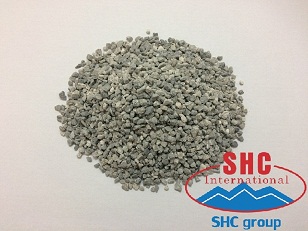During the production of iron by blast furnace (BF) route, dolomite is added either in the process of sintering or as a direct feed in the blast furnace. Raw dolomite is normally used for this addition. Dolomite addition is made during ironmaking for obtaining desired percentage of MgO in the BF slag. Addition of dolomite through sinter is more preferred route since CO2 of dolomite is driven out during the sintering process. In case of sintering, dolomite is crushed to -3 mm (in the range of 85 % to 90 %) in hammer crushers before mixing it in the sinter mix. In case of direct feed to blast furnace, lump dolomite (10 mm to 30 mm size) is used.

In case of dolomite addition through sintering, these days calcined dolomite is alsodirectly being used. Use of calcined dolomite in the sintering process has the advantages of (i) Improvement in the binding characteristics of sinter mix, (ii) improvement in the productivity of sintering machine, (iii) improvement in the sinter strength, and (iv) reduction in the volume of exhaust gases with associated advantages.
High silica (SiO2) content in the dolomite used for sintering purpose is preferred since SiO2 counter the effect of alumina (Al2O3) in the blast furnace.
In the production of direct reduced iron (DRI) by the rotary kiln process, dolomite is used as a desulphurizing agent. Raw dolomite is used in the size range of 4 mm to 8 mm.

The second major use of dolomite is in steelmaking. In steelmaking dolomite is used both as a fluxing material and also as a refractory material. For use in steelmaking, the SiO2 (because of its acidic nature) content in the dolomite is to be very low preferably less than 1 %. When it is used as a fluxing material, it is used in calcined form. As a fluxing material, it has a dual role. In its first role it is a source of some lime (CaO) and thus reduces the consumption of calcined lime. But the second role of calcined dolomite is the more important role. In this role it is used to protect the magnesia-carbon lining of the steelmaking vessel. This is done by making a steelmaking slag which is super saturated in MgO at the temperature of steelmaking.
These days slag splashing technology is being used extensively for the enhancement of the lining life of the BOF (basic oxygen furnace) vessel. In this technology, calcined dolomite is added to the retained liquid slag which is to be splashed on the BOF vessel. This is done to enhance the viscosity of the slag so that it can have better sticking properties and also to enhance the refractoriness of the slag.
Calcined dolomite is also increasingly being used as a part of synthetic slags usually added during ladle metallurgy. This is done to protect the ladle lining especially at the slag line.
When dolomite is used as refractory material, then it is used in form of sintered dolomite. Sintered dolomite is used in steel making for the production of tar dolomite bricks, pitch impregnated dolomite bricks or resin bonded dolomite bricks for the lining of BOF vessel, AOD (argon oxygen decarburization) vessel, and to a lesser extent electric arc furnace. These bricks are also used for the lining of the steel ladles.
Dolomite based monolithic refractories such as gunniting mixes are also used for the maintenance of the refractories of the steelmaking furnaces. Gunniting is normally done in those areas of refractory lining where there is high wear. These refractories are also used to form the hearth and banks in EAF, and to maintain them on a regular basis. The maintenance of these areas is often carried out using a high iron, sintered dolomite which is applied on a frequent basis between heats using a spinning machine. The machine is lowered into the furnace and applies several tons of fettling material in a couple of minutes between the heats. This fast, low cost solution is used particularly in those parts of the furnace where there is fast wear of refractories.
elephone: +84 936 212 598
Hotline: +84 986 358 011 (Whatsapp / Wechat) - Mr. Thomas
Email: export2@shcgroup.vn
Skype: export2@shcgroup.vn




